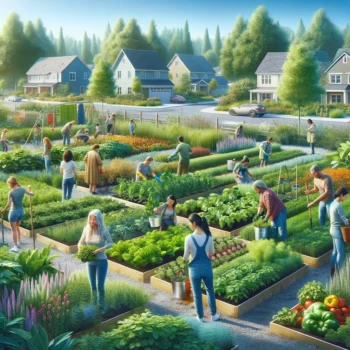By Oliva Wilson
Staff writer for Wake Up World
In an era marked by global challenges, food security remains a pressing issue in developed and developing nations. Our food systems exhibit profound fragility, with agricultural practices and distribution networks often failing to achieve sustainability and resilience. Alarmingly, this seems to be by design, as current issues faced by farmers are exacerbated by restrictive policies imposed by governments around the world, further complicating efforts to stabilize and improve these critical systems.
Food security transcends the mere availability of fresh, local produce; it encompasses the robustness of the entire food-producing and distribution chain. While supermarkets might offer an illusion of abundance, the reality is a delicate balance, where a single disruption can jeopardize the whole supply chain. This fragility in our food systems is a critical concern that demands immediate and sustainable solutions.
[pro_ad_display_adzone id=”110028″]
Building Community Resilience Through Gardening
Grassroots Movements and Their Impact
Addressing food security requires a multi-tiered approach involving governments, businesses, and community initiatives. At the heart of community-driven solutions are grassroots gardening movements, which have proven to be potent tools for fostering local resilience and sustainability.
Globally, numerous communities have taken significant strides in enhancing food security through urban gardening projects. These initiatives provide practical lessons that can be replicated and help strengthen community bonds and local economies.
Community Gardens and Allotments: Pioneering Local Food Production
Community gardens and allotments offer a proactive way for communities to take control of their food sources. These communal spaces can vary immensely in size and scope, utilizing diverse urban areas from city parks and municipal lands to rooftops and reclaimed industrial sites.
These gardens do more than just produce food; they enhance community cohesion, provide educational opportunities, and promote sustainable living practices. Every new garden established is a step towards mitigating food insecurity risks.
Garden Sharing: Extending the Reach of Urban Green Spaces
Not everyone has the luxury of owning a garden, but those who do can play a pivotal role in enhancing food security. By sharing their garden space or the harvest, garden owners can provide invaluable resources to those without access to land.
Garden sharing is not just about lending land; it’s about building a community of shared values and collective responsibility toward sustainable living.
Gardening Groups and Knowledge Exchange
Individual efforts in gardening can collectively lead to substantial community benefits. Local gardening groups act as vital hubs for sharing expertise and fostering a culture of growth and sustainability. They are crucial in spreading essential gardening skills and encouraging more residents to participate in food production.
My Top 7 Tips for Starting a Community Garden
1. Assess Community Needs and Goals
Before breaking ground on a new community garden, engaging with your community to understand its needs and aspirations is crucial. Conduct surveys, hold meetings, and gather input to ensure the garden serves a functional purpose—whether it’s for food production, educational opportunities, or a communal gathering space. This initial step helps tailor the garden’s design and operations to truly reflect and satisfy the community’s desires, fostering a sense of ownership and commitment from the outset.
2. Choose the Right Location
Selecting an optimal location is fundamental to the garden’s success. Look for spaces that are easily accessible to all community members, including those with disabilities. Consider factors like sun exposure, water availability, and soil quality, which are critical for plant growth. Also, the site should be safe and welcoming, ideally visible to the public, to encourage community interaction and deter vandalism.
3. Start Small
Begin with small, manageable plots that can realistically be maintained by your current group of volunteers. Starting small allows your gardening community to gain confidence and experience, which is crucial for gradually scaling up the garden. Small successes in the early stages build momentum and can attract more volunteers and resources as the garden grows.
4. Foster Inclusivity
A community garden should be a space where everyone feels welcome. Make inclusivity a core principle by accommodating gardeners of all ages and abilities. Consider raised beds for those with difficulty bending or kneeling, and create child-friendly areas that encourage young gardeners to learn and participate. Offer roles that suit various levels of physical ability and time commitments, ensuring everyone can contribute.
5. Organize Regular Workshops
Education is key to a thriving garden. Organize regular workshops covering various topics, from sustainable gardening practices and organic pest management to seasonal planting and composting. These workshops improve the participants’ skills and strengthen the community by building knowledge that can be shared beyond the garden.
6. Promote Sharing and Collaboration
Encourage a culture of sharing and collaboration among garden members. This can involve the communal use of tools, seeds, and other resources, reducing individual costs and promoting a sense of collective responsibility. Facilitate regular meetings or social events where gardeners can exchange ideas, solve problems together, and share their harvests. This collaborative environment not only enhances productivity but also deepens social connections within the community.
7. Celebrate Successes
Recognizing the efforts and achievements of all participants is crucial in sustaining long-term interest and engagement. Organize community events like harvest festivals, plant swaps, or potluck dinners where gardeners can showcase their produce and celebrate their hard work with the wider community. These celebrations can serve as both a reward for the gardeners and a promotional event to draw more community interest and support.
By following these tips, you can significantly increase the chances of your community garden becoming a sustainable and integral part of the local environment, providing benefits that extend well beyond the harvest.
Conclusion: Cultivating Change from the Ground Up
Urban gardening and community-driven agricultural initiatives are more than just food security projects; they are transformative movements that rebuild connections between people and their food sources. By embracing these practices, communities strengthen their resilience against food system disruptions and pave the way for a sustainable and equitable future.
Embrace the power of community gardening and contribute to a more secure and sustainable tomorrow—one plant at a time.
Book Recommendations:
-
- The Organic Gardener’s Handbook of Natural Insect and Disease Control by Barbara W. Ellis and Fern Marshall Bradley
- Rodale’s Basic Organic Gardening: A Beginner’s Guide to Starting a Healthy Garden by Deborah L. Martin
- Gaia’s Garden: A Guide to Home-Scale Permaculture by Toby Hemenway
About the Author
Olivia Wilson is a passionate writer with a green thumb and a heart for healthy living. Through her articles, she aims to inspire others to cultivate vibrant gardens and nourish their bodies and souls through the power of nature. When she’s not tending to her garden or experimenting with new recipes in the kitchen, she can be found exploring local farmers’ markets or enjoying a peaceful hike in the great outdoors.
[pro_ad_display_adzone id=”110027″]







